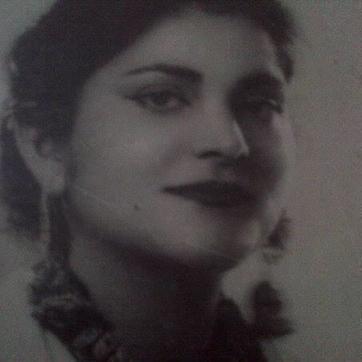|
Sabeeha, the lady of the lotus 1. Her daughter gave her the red diary, with a sketch or a poem printed on each page, as a gift for her fifteenth wedding anniversary in February. She had a meeting that morning, and a formal dinner to attend in the evening. Her husband had a difficult day. He didn’t want to go. The next day she was at the airport at noon, to receive the Mother of the Nation who was coming home from a trip abroad. Later, a meeting at her sister-in-law’s house, to discuss the situation and progress of Muslim women. Her husband told her he’d had disturbing news. In the diary, she wrote: Just when I feel on the edge of a discovery – an illumination. Between then and June, after her opening entries, she used it only to write down the words of the songs she was learning. Her handwriting intertwined with the printed words and pictures on the pages. 2. June was a musical month. Her teacher, whom she called Khan Sahib, invited connoisseurs of classical music, including Shahid Ahmad, the editor of the literary journal Saqi, to hear her sing. She performed three raags – khambavati, anandi and des – without making a single mistake. Her teacher was quite satisfied, her husband was pleased, the audience impressed. She was thinking of her deadline: a text to be handed over to She the next morning. A musician from Bengal, Begum Jabbar, played the sitar very well. ** She sang khambavati and darbari. Her teacher was satisfied, she wasn’t. She missed a farewell party for her friend Jane who was going back to America. At the next session four days later, Begum Jabbar played well again, Khan Sahib sang well, and her songs were well-appreciated. Her husband was very pleased with her singing, her teacher exultant. ** Two days later, she was singing again at a concert; she didn’t feel she sang too well, her teacher was most dissatisfied. There was a series of dinners to attend before the music conference at the new Arts Council began. Amanat Ali and Fateh Ali were performing on the opening night, she enjoyed their recital; on the second, Nazakat Ali and Salamat Ali were good in parts, but she was bored by the vocal gymnastics of Roshanara, Queen of Song. . ** She started to learn the new darbari tarana. It was a composition by Tan Ras Khan. She tried to sing a thumri in bhairavi, with her own improvisations and embellishments, but she didn’t make it. She practiced darbari in the evening s for twenty minutes. She cancelled a party at her friend Suad’s, to practice a new malhar, but he made her sing anandi. ** She waited for him at 5.30 and he appeared at 8.30. She wanted to sing the malhar she’d learnt but instead he made her sing aiman and kedara. ** June was ending, and she had another deadline, for the Morning News this time. ** She wanted to sing malhar. He made her sing darbari. She wanted something new and he made her repeat old lessons. Then he started her on a new raag, mian ki todi. She practiced des and bhopali, shifted to bahaar, wanted to sing the rest of them, but he moved her to malhar. She’d hoped he’d teach her the new string, but he made her revise the oldest. She didn’t like them much. ** A full darbari with a new tarana, and a new khambavati at last. Satisfied (she writes). 3. She notes her deadlines in the diary, but she doesn’t write about driving her children to school in the mornings four miles from P.E.C.H.S to Clifton, or picking them up for lunch. She mentions the parties she attended, but not the night she came back laughing because the Portuguese Ambassador had called her the Maria Callas of Karachi. She doesn’t record the passing of the seasons, the walks to the lake in the mild evening breeze, the flowers and fruit she grows, or the frangipani fallen on wet grass or picked off the branch in the morning for her hair. 4. July. Khan Sahib arrived unexpectedly. She revised anandi, learnt a new khambavati. Some beautiful new improvisations: Satisfied ( she writes). ** A few days late, another unexpected visit. From Jahan Khan this time, her teacher’s maternal uncle. He started her on khambavati. Ai ri mi jagi piya bin sagri rain Jab se gaye mori sudh hu na leni , kaise kahun man ki batiyan….. Ustad Jahan Khan comes by regularly now (she writes). Her pages were filling up with the lyrics of the songs she learned. She was practising ornamentation, alankaar, in khambavati. 5. In August Ustad Jahan Khan brought her voice down to a lower pitch by half a note. She sang all her songs without the accompanying harmonium. The discovery amazed her and surprised everyone. She was not very satisfied with her voice at that pitch. The next day her teacher tried out the old raags at the new pitch, with only the tanpura. Every note was in tune. He will teach me morning raags in the morning (she writes) and come in the evening to teach me evening raags. 6. After trying out several raags in Khayal, Ustad Jahan Khan struck upon Dhrupad, which her husband liked very much. She started to learn Raag Durga in the Dhrupad mode, with the Khamach rhythm; unusual and rarely recognised. She sang with the pakhwavaj, a single, two-faced drum, instead of the usual paired tablas. Eri mai nand kunwar eri mai nand kunwar eri mai nand kunwar maaa-aai nand kunwar maa-aai nanda Her voice throbbed and soared. 7. When a blister appears on the first forefinger (she writes) it is a sign that you have achieved the perfect pitch. One hour a day should be set aside, sacredly, for the practice of taans and sur sadhan: the art of song. 8. Her children will remember the concerts in the garden on nights lit up by flares or by the moon, they remember the songs and remind her of them, when she sang what, and even the words and melodies. They sat around her as she sang, or listened from the open window. They learnt her songs like the grey African parrots in their aunt’s big cage, half-understanding the words; they delighted her by singing raags in the bath, but when she persuaded them to take formal lessons all but her middle daughter would run away. They will remember her favourite book: the The Lady of the Lotus, illustrated with classical miniatures: a story from her native Malwa, of Baz Bahadur and the poet-singer Roopmati, whose melancholy verses their mother set to music and sang. Years later, her son will find her a copy of the book she lost in transit, and find some of those verses. But it’s a new edition. Had I but known what pain with love would come, had I but known Jo main aisa jaanti preet ki ye dukh hoe I would have banished him by beat of drum, had I but known Nagar dhandora peetti preet na kariyo koe Did the rain fall that year of 1963? None of them remembers now: they think it never came. They remember, though, all the years she longed for rain and missed her native Malwa, and how she exulted when it finally fell. 9. After trying her voice out in several pitches, Ustad Jahan Khan brought it back to the original note. He said he’d been worrying over it for days. 10. So what did it mean to you, the singing? Her son will ask her as he transcribes, and reads back to her the words of her diary. She remembers it all, the rooms, the faces, the applause, the ecstasy and the fall. Expression, she will reply, and release. The poetry in the music is thought, and through singing I expressed those thoughts. Sometimes late at night the lady of the lotus will sing to herself, those songs, of rainfall, separation and exultation. Later, her son, who never wanted to, will also sing to find release. But one night, he will stop in mid-song, terrified of the audience around him and the failure of his voice, and swear he’ll never sing on stage again. He exchanges the ecstasy of music for the dry solace of thoughts; he’ll write, but he inherits from her the pursuit: of austere phrase, soaring note, throbbing pulse, blistered forefinger. 11. She abandoned the diary with a final, terse entry. 23rd Nov 1963. Dinner at Khan Sahib’s house. Music after dinner. Sang Darbari. No exhilaration after singing. After this, there are only poems, wedding songs and musical notations. 12 Antra in des: Sa sa re re re re ma ma ma ma pa pa pa ma pa pa Ma pa ni ni ni ni ni sa ni sa sa re ni dha ni pa Taan: re ma pa dha ma ga re/ga ni sa  Born and brought up in Karachi, Aamer Hussein studied for two years in the Nilgiris, India, before moving to London, aged 15, in 1970. He worked in the now defunct BCCI, took a degree in South Asian studies from SOAS, and later studied French, Philosophy and Psychoanalysis. He began to publish short fiction, reviews and articles in journals and anthologies in 1987. His first collection of stories, Mirror to the Sun, appeared in 1993, to be followed by three further collections – including Insomnia – and two novels, Another Gulmohar Tree (2009) and The Cloud Messenger (2011). His latest work is 37 Bridges and Other Stories (2013). He writes in both English and Urdu, still lives in London, and travels frequently to Pakistan.
3 Comments
Shahrukh Husain
10/20/2016 03:14:19 am
Moved to tears. exquisite.
Reply
yasmine pawar
10/28/2016 04:46:56 am
incredibly evocative
Reply
10/28/2016 05:54:41 am
Beautifully written and deeply stirring. The ache in the music sweeps over narrator and reader. Thank you Aamer.
Reply
Leave a Reply. |
StrandsFiction~Poetry~Translations~Reviews~Interviews~Visual Arts Archives
April 2024
Categories |

 RSS Feed
RSS Feed